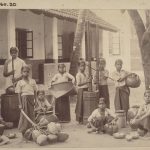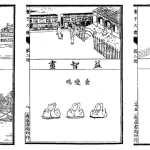The black and white photograph is jarring in its contradictions: a small Vietnamese boy, likely no more than ten years old, holding what appears to be a military rifle. His expression is neither frightened nor aggressive; instead, there is a studied concentration, a premature seriousness that speaks to experiences far beyond his years. This image, captured in the Central Highlands of Vietnam in 1968, challenges our modern Western notion of childhood as a protected space of innocence and play, a concept that itself has evolved historically and isn’t universal.[1] Instead, it presents a stark reminder of how conflict reshapes the boundaries of childhood, creating young people who simultaneously inhabit the worlds of child and adult, victim and survivor, refugee and adapter.
The fall of Saigon in 1975 marked the end of the Vietnam War and triggered a massive refugee crisis. Among the thousands who fled were many children who would eventually find new homes in Arkansas. Fort Chaffee, a military installation near Fort Smith, became one of four main U.S. refugee processing centers, welcoming over fifty thousand Vietnamese refugees. Within this population, children under sixteen constituted nearly half of all refugees processed at the facility, bringing with them complex histories that traditional narratives of both war and childhood often fail to capture.[2]
The photograph of the child with the gun serves as a powerful entry point into these overlooked histories. It raises questions that extend beyond a single moment captured on film: How did Vietnamese children experience the trauma of war and displacement? In what ways did they navigate the blurred boundaries between childhood and adulthood during crisis? How did these experiences shape their adaptation to life in Arkansas? And what can this particular history tell us about the broader relationship between childhood, conflict, and resilience?
This piece explores these questions through the lens of Vietnamese refugee children who came to Arkansas in the aftermath of the Vietnam War. Drawing on historical records, documented experiences, and artifacts from a recent exhibition I curated, it examines how these children’s experiences challenge many of our understandings of childhood while highlighting their remarkable capacity for adaptation, cultural bridging, and community building, a legacy that continues to shape Arkansas to this day.
The Hidden Histories of Refugee Children
The Vietnam War’s impact on children has often been overlooked in historical narratives that focus on military and political aspects of the conflict. The stories that dominate our collective memory of the war – helicopter evacuations, military operations, and political negotiations – frequently portray children as passive victims or background figures rather than historical actors in their own right. The photograph of the Vietnamese child soldier disrupts this narrative, forcing us to confront the complex roles children played during the war and its aftermath.
Despite their significant numbers, children’s specific experiences were often subsumed within broader refugee narratives. A 1975 U.S. Government Policy Document, revealed by the CIA, outlining key justifications for admitting Vietnamese refugees, paid minimal attention to the distinct needs and experiences of children, reflecting how official policy often overlooked the youngest refugees.[3]
The journey from Vietnam to Arkansas took these children across both geographical and psychological distances. For many children, America existed as an almost mythical place beyond comprehension.
Recovering these hidden histories requires piecing together fragments, photographs like the one of the child with the gun, brief mentions in official reports, and documented experiences shared decades later. Through these fragments, we can begin to reconstruct how Vietnamese refugee children experienced the transition from war-torn homeland to new communities in Arkansas, acknowledging both their vulnerability and their agency.
The Complicated Reality of Vietnamese Refugee Children
For Vietnamese children, the journey to Arkansas began with traumatic departures from their homeland. Lieutenant Colonel Kevin Tran’s experience of arriving at Fort Chaffee in August 1975 as a young refugee is a touching one. He remembers the flight from Guam to the U.S. as “one of those first memories of my life” because it was his first time drinking a Coca-Cola.[4] This simple childhood memory sits alongside the harrowing escape his family made just days before Saigon fell.
Many refugee children shouldered adult burdens in significant ways. At Fort Chaffee, Vietnamese children often served as interpreters between their families and American society. Children typically learned English faster than adults, becoming crucial cultural navigators for their families. We can also see this from Tran’s experience; his family prepared for their first American Halloween, and it was the children who helped bridge the cultural gap. “They had to teach us about Halloween…, the main sponsor tried to explain about kids dressing up in costumes and knocking on your door, and you must give them candy. We were baffled. What tradition or custom was this?” Tran narrated. [5]
Meanwhile, these same children sought moments of childhood normalcy. Tran remembers wandering around Fort Chaffee, finding a nickel on the ground, and feeling “like a millionaire at the time. The first thing I did was go and buy some candy and ice cream. I was a happy-go-lucky four-year-old.”[6] This juxtaposition, a child helping his family understand American customs one moment, and experiencing simple childhood joy the next, captures the dual worlds Vietnamese refugee children inhabited.
The humanitarian response to the crisis created unexpected long-term cultural enrichment and economic benefits for Arkansas. Vietnamese restaurants, businesses, and cultural celebrations have become integral parts of communities from Fort Smith to Little Rock. This integration was facilitated in large part by the children, who grew up straddling both cultures and helping their families navigate their new home.[7]
From Fort Chaffee to Arkansas Communities
The transition from Fort Chaffee to permanent homes presented refugee children with new challenges and opportunities. After three months at Fort Chaffee, Tran’s family was sponsored by Catholic families in Texas who helped them settle into American life. This pattern repeated across Arkansas communities, where sponsor families, churches, and community organizations helped Vietnamese families establish new homes.[8]
Vietnamese children typically adapted faster to their new environments, but often carried unspoken anxieties. Yet many, like Tran, found ways to build successful lives. Decades after arriving as a refugee child, Tran returned to Fort Smith as a Lieutenant Colonel in the U.S. Air Force. “It’s like a giant circle,” he reflected. “Fort Smith people helped me settle in as a child, and now I’m helping others settle here. Fort Chaffee was the launching point for the life I have now. It’s like I’m passing the baton, but under different circumstances.”[9]
This full-circle journey raises important questions about what “successful” adaptation means. Does success require assimilation, or can it include maintaining Vietnamese cultural traditions? The answers vary widely among former refugee children, reflecting the diversity of their experiences and choices.
Legacy and Meaning Today
The legacy of Vietnamese refugee children in Arkansas extends beyond individual success stories. The children who once struggled to understand American customs now maintain Vietnamese cultural traditions while fully participating in American society.
Their experience offers valuable insights for our understanding of today’s refugee children, whether from Syria, Afghanistan, Central America, or Ukraine. The Vietnamese experience demonstrates both the tremendous adaptability of children and the lasting impacts of early displacement.
The role of refugee children as cultural mediators remains remarkably relevant. Like their Vietnamese predecessors, today’s refugee children often learn new languages faster than their parents and serve as bridges between cultures. This role brings both opportunities and burdens. The Vietnamese experience suggests that supporting children’s unique position as cultural navigators, rather than expecting complete assimilation, can lead to more successful long-term outcomes for refugee families.
Conclusion
As we reflect on this history, nearly fifty years after the fall of Saigon, we can appreciate how refugee children navigated unique developmental challenges while also recognizing their tremendous capacity for adaptation and growth. The Vietnamese refugee experience demonstrates how children can maintain connections to their cultural heritage while embracing new identities and opportunities. It shows how trauma and resilience can coexist within the same young lives.
With all these factors considered, it is safe to say that Vietnamese refugee children are the reason why Vietnamese culture is still available in Arkansas today. Through their agency, they navigated American society, becoming masters of the complex terrain between assimilation and cultural preservation.
In studying these histories, we gain not only a deeper understanding of the Vietnamese refugee experience but also valuable insights into childhood itself: its vulnerability to disruption, its remarkable adaptability, and its central role in cross-cultural exchange. The photograph of the child soldier becomes not just a record of a historical moment but an invitation to rethink our assumptions about childhood, conflict, and resilience in ways that might inform our response to refugee children in our own time.
Noah Adebanjo is pursuing a Master’s in Public History at the University of Arkansas at Little Rock, specializing in Digital Archiving and Public History. He works as a Graduate Assistant at the Center for Arkansas History and Culture and am also a Fellow at the Clinton Presidential Library and Museum. Most recently, he curated an exhibition on Vietnamese refugee children in Arkansas, which inspired this article. You can check out the exhibit here.
[1] Philippe Ariès, Centuries of Childhood: A Social History of Family Life (New York: Vintage Books, 1962).
[2] Center for Arkansas History and Culture: Digital Exhibit-Striving for Place (Stories of Vietnamese Refugees in Arkansas)
[3] U.S. Government Policy Document, 1968, YouTube video, The Life Guide – The Vietnam War, November 1, 2019, https://www.youtube.com/watch?v=7tNTh6KlXXU.
[4] Jessica Wilson, “Former Refugee Turned Lieutenant Colonel Visits Fort Chaffee,” Defense Visual Information Distribution Service, August 11, 2022, https://www.dvidshub.net/news/427088/former-refugee-turned-lieutenant-colonel-visits-fort-chafee.
[5] Ibid.
[6] Ibid.
[7] Sucheng Chan, The Vietnamese American 1.5 Generation: Stories of War, Revolution, Flight, and New Beginnings (Philadelphia: Temple University Press, 2006). 40/29 News, Fort Smith’s Vietnamese Community Celebrating Lunar New Year, YouTube, January 29, 2025, https://www.youtube.com/watch?v=EcrgkZOOOY8.
[8] Wilson, “Former refugee turned Lieutenant Colonel visits Fort Chafee’’
[9] Ibid.






